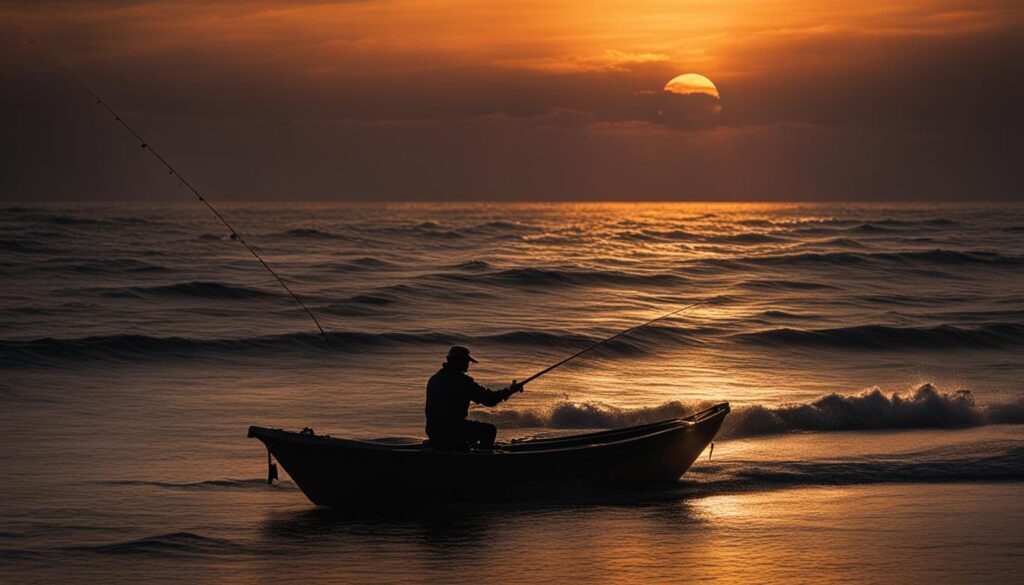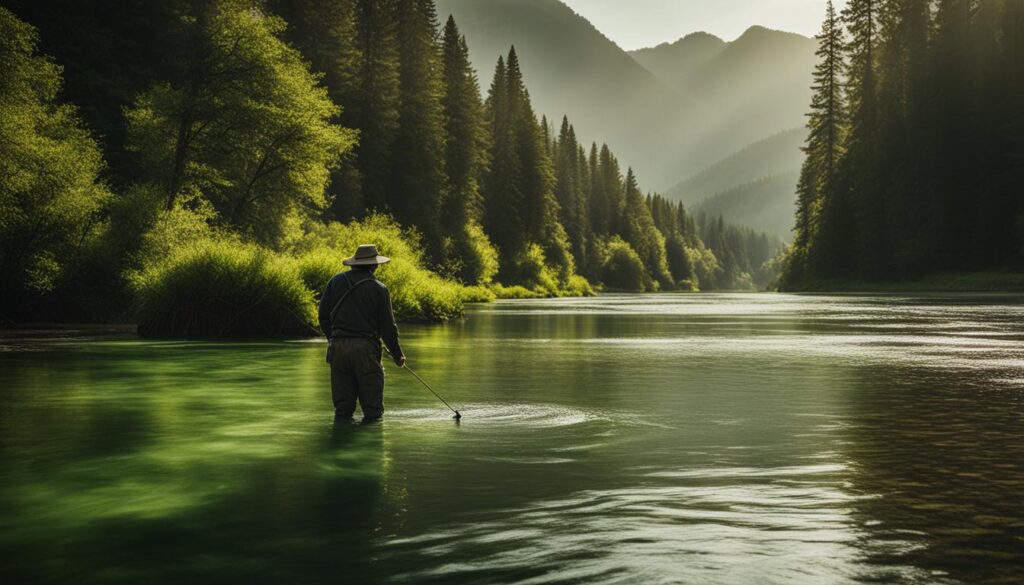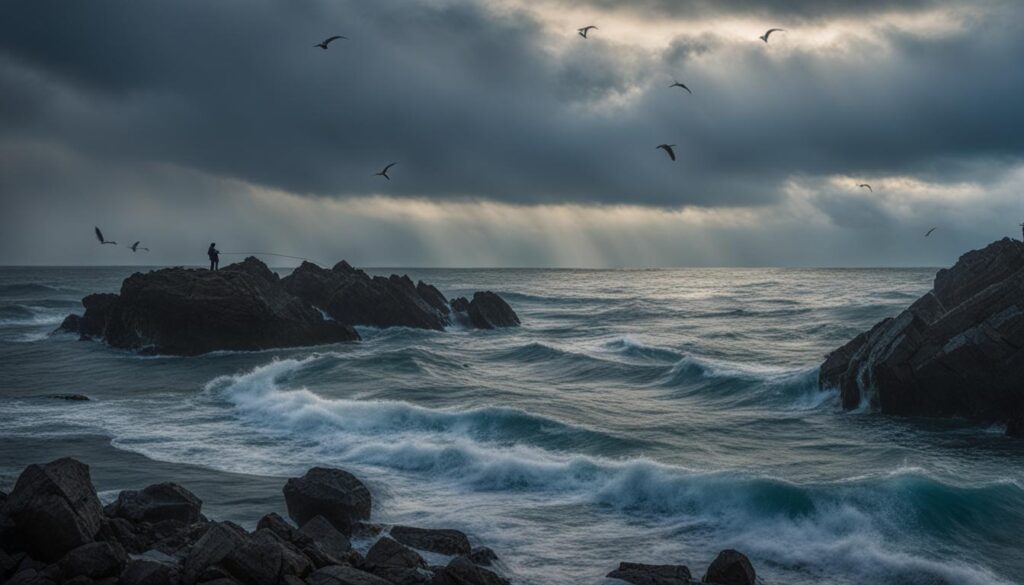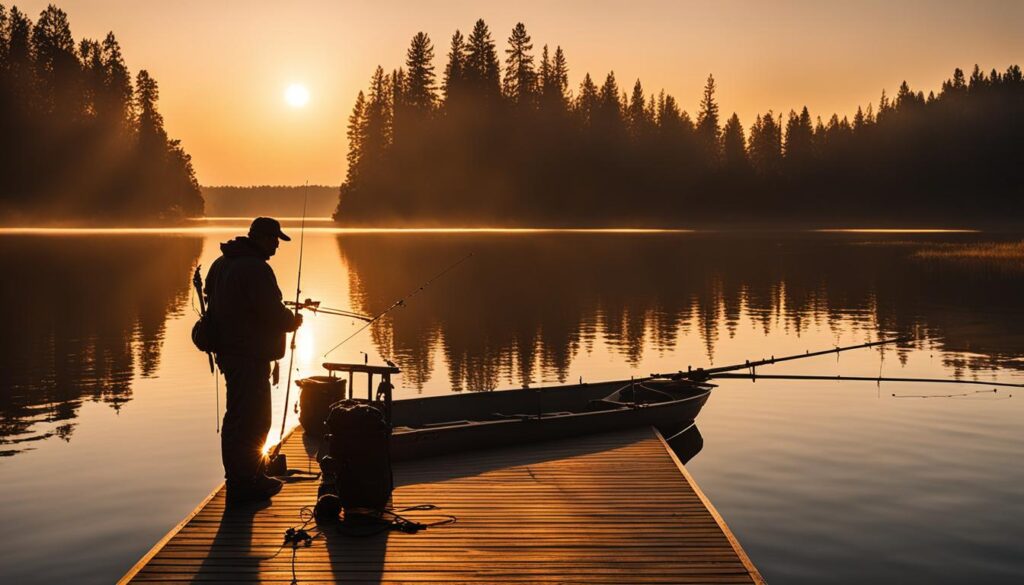We may earn money or products from the companies mentioned in this post.
There’s nothing quite like the thrill of deep sea fishing. From the exhilarating rush of reeling in a big catch to the peaceful tranquility of being out on the open ocean, it’s an experience like no other. But to truly make the most out of your offshore adventures, you need to be armed with the right knowledge and skills. In this section, we will explore expert deep sea fishing tips that will help you become a master at fishing in the deep sea. Whether you’re a beginner or an advanced angler, these tips will give you the edge in your offshore adventures.
Key Takeaways
- Expert deep sea fishing tips can help you become a master at fishing in the deep sea.
- Whether you’re a beginner or an advanced angler, these tips will give you an edge in your offshore adventures.
- From essential tips for beginners to advanced techniques for seasoned anglers, we’ll cover all the bases.
- Selecting the right gear and locating the best fishing spots are crucial for a successful deep sea fishing trip.
- Knowing how to catch different deep sea fish species requires specific techniques and bait.
Essential Deep Sea Fishing Tips for Beginners
If you’re a novice at deep sea fishing, follow these tips to get started:
- Choose the right time: The best time to go deep sea fishing is during the summer months when the waters are calm. Check the weather forecast before you go to avoid rough seas.
- Get the right gear: Invest in a good-quality rod and reel combo that is suitable for deep sea fishing. Choose a rod that is sturdy and has a sensitive tip to help you feel for bites. For beginners, a spinning reel is easier to use than a baitcaster.
- Learn basic fishing techniques: Start with the basics, like how to properly cast and reel in your line. Practice tying knots and baiting hooks before your trip.
- Use the right bait: Deep sea fish are attracted to live bait such as squid, shrimp, and mackerel. Ask your captain or local tackle shop for recommendations.
- Be patient: Deep sea fishing requires patience, as it may take some time to catch a fish. Stay focused and keep reeling in your line, even if you don’t get a bite right away.
- Stay safe: Wear appropriate clothing and a life jacket, and follow all safety rules and procedures. Listen to your captain’s instructions and be aware of your surroundings.
By following these beginner deep sea fishing tips, you’ll be on your way to a successful and enjoyable fishing trip.
Advanced Techniques for Deep Sea Fishing Enthusiasts
If you’re an experienced angler looking to take your deep sea fishing skills to the next level, these advanced techniques will help you reel in the catch of a lifetime.
Trolling for Big Game Fish
Trolling is a highly effective method for catching big game fish like marlin, sailfish, and tuna. It involves dragging lures or bait behind the boat while cruising at a slow speed. The movement of the boat creates the impression of live prey, attracting the fish to strike. When trolling, it’s essential to use the right gear, including heavy-duty rods, reels, and lines capable of withstanding the weight of the catch.
Bottom Fishing for Snapper and Grouper
Bottom fishing is a popular technique for catching bottom-dwelling fish like snapper and grouper. To use this technique, you’ll need to drop your bait or lure to the ocean floor and then reel it in slowly. It’s essential to keep the line taut to feel the bite and set the hook quickly. Bottom fishing requires patience and persistence, but it can be incredibly rewarding when you finally land a big catch.
Casting for Mahi-Mahi
Mahi-Mahi, also known as dolphin fish, are known for their speed and fighting ability, making them a popular target for anglers. To catch these elusive fish, you’ll need to use a technique called casting. This involves casting lures or bait out into the ocean and reeling them in rapidly to mimic the movement of small fish. Mahi-Mahi are known for their acrobatics, so be prepared for an exciting fight when you hook one.
| Advanced Deep Sea Fishing Tips: | Deep Sea Fishing Techniques: |
|---|---|
| Use a fish finder to locate schools of fish | Trolling |
| Change your bait or lures regularly to keep the fish interested | Bottom Fishing |
| Experiment with different retrieval techniques to find what works best for the fish you’re targeting | Casting |
| Pay attention to the weather conditions and adjust your technique accordingly |
“The key to success in deep sea fishing is to always be learning and experimenting with new techniques.”
By using these advanced deep sea fishing tips and techniques, you’ll be able to tackle even the most challenging fish and improve your chances of landing a big catch. Remember to always prioritize safety and be prepared for any situation on the water.
Choosing the Right Gear for Deep Sea Fishing
When it comes to deep sea fishing, having the right gear is essential for a successful and enjoyable trip. From rods and reels to lines and tackles, selecting the right equipment can make all the difference. Here are some tips on choosing the best gear for your deep sea fishing adventure.
Rods
Deep sea fishing requires sturdy and durable rods that can handle the weight and strength of large fish. Look for rods that are at least 6 feet in length and made of graphite or fiberglass for maximum strength. Longer rods can cast further, which is important when fishing in deeper waters.
Reels
When selecting a reel, choose one with a high line capacity and a strong drag system. This will allow you to handle larger and more powerful fish. Consider a conventional reel for bottom fishing, as it offers more control and precision. A spinning reel is better suited for casting and trolling.
Lines
Deep sea fishing requires heavier lines that can withstand the pressure of deep waters and large fish. Look for lines with a test weight of at least 30 pounds. Monofilament lines are cheaper and easier to handle, but braided lines are thinner and stronger, offering better casting distance and sensitivity.
Tackles
There are several types of tackles you’ll need for deep sea fishing, including sinkers, swivels, hooks, and lures. Sinkers are needed to keep your bait at the right depth, while swivels prevent your line from twisting. Hooks should be strong and sharp to ensure a good hookset, and lures should mimic the natural prey of the fish you are targeting.
| Tackle | Best Use |
|---|---|
| Jigs | Bottom fishing for snapper and grouper |
| Plugs | Trolling for tuna and marlin |
| Squid skirts | Trolling for mahi-mahi and wahoo |
Remember to choose tackles based on the type of fishing you will be doing and the species of fish you are targeting.
By selecting the right gear for deep sea fishing, you can increase your chances of having a successful trip. Make sure to do your research and invest in quality gear that will last for years to come.
Locating the Best Fishing Spots in the Deep Sea
Finding the best fishing spots in the deep sea can be a challenging task. It requires an understanding of various factors, such as water temperature, depth, and the type of fish you’re looking to catch. Below are some techniques that can help you locate the best fishing spots.
1. Read Charts
One of the most effective ways to locate the best fishing spots in the deep sea is by reading charts. Nautical charts provide valuable information about the sea’s topography, including water depth and underwater features. Charts also indicate areas with high concentrations of baitfish, which attract larger predatory fish.
| Tip | Description |
|---|---|
| Focus on drop-offs | Pay attention to areas where the depth of the water drops significantly. These areas indicate underwater mountains, trenches, and other structures that attract large fish. |
| Look for underwater structures | Areas with underwater structures, such as reefs, rock pinnacles, and underwater mountains, are excellent fishing spots. These structures provide shelter for baitfish, which attract larger, predatory fish. |
2. Understand Water Temperatures
Water temperature plays a critical role in determining the location of fish in the deep sea. Different fish species prefer different water temperatures, and knowing their preferences can help you locate their habitats.
For example, yellowfin tuna prefer water temperatures between 72 and 82°F. Marlin, on the other hand, prefer water temperatures above 68°F. By understanding the water temperature preferences of different fish species, you can use your fish finder to locate their habitats.
3. Use Technology to Your Advantage
Advancements in technology have made it much easier to locate the best fishing spots in the deep sea. Fish finders, for example, use sonar technology to detect underwater structures and schools of fish. They can help you locate schools of baitfish, which attract larger predatory fish.
Another technological tool is satellite imagery, which provides a bird’s eye view of the ocean’s topography, including sea surface temperature, currents, and chlorophyll concentration. This information can help you locate the best fishing spots in the deep sea.
4. Look for Birds
One of the easiest ways to locate fishing spots is by keeping an eye out for birds. Seabirds, such as seagulls, terns, and pelicans, often hover over schools of baitfish, which attract larger predatory fish. If you see seabirds hovering over a particular area, it’s likely an excellent fishing spot.
5. Follow Other Fishermen
If you’re new to deep sea fishing, one of the best ways to locate fishing spots is by following other fishermen. Local fishermen have years of experience fishing in the area and know the best spots to catch different fish species. Strike up a conversation with them and ask for their advice. They may be willing to share some of their best-kept secrets.
- Reading charts, understanding water temperatures, using technology, looking for birds, and following other fishermen are some of the techniques that can help you locate the best fishing spots in the deep sea.
- Remember to always practice proper safety precautions while deep sea fishing and follow local fishing rules and regulations.
Techniques for Catching Different Deep Sea Fish Species
Deep sea fishing is an exciting activity that allows you to catch a wide variety of fish species. Each species requires different techniques to lure and catch them successfully. Here are some tips to help you target specific fish species when deep sea fishing.
Marlin
Marlin is a highly prized catch for many deep sea anglers. When targeting marlin, use a combination of trolling and live bait techniques. Troll large lures with bright colors and flash to attract their attention. Live bait, such as bonito or mackerel, can also be used to entice them.
Tuna
Tuna is another popular fish species found in the deep sea. To catch tuna, try using a combination of chunking and live bait techniques. Chunking involves cutting up small pieces of baitfish and chumming the water to attract the tuna. Once they start feeding, cast a live baitfish into the area to tempt them further.
Swordfish
Swordfish is a challenging and rewarding catch for many anglers. To catch swordfish, you’ll need to use deep drop techniques. This involves dropping a baited line to depths of around 1,500 feet or more, where swordfish often dwell. Use bait such as squid or mackerel to lure them in.
Snapper
Snapper is a tasty catch that can be found in the deep sea. To catch snapper, use a combination of bottom fishing and chumming techniques. Anchor your boat over a reef or structure that snapper frequent and drop lines baited with cut baits or jigs. Chumming the water can also attract them to your location.
Grouper
Grouper can also be found around reefs and structures in the deep sea. To catch grouper, use a combination of bottom fishing and jigging techniques. Drop lines baited with cut baits or live baitfish to the bottom and wait for the bite. Jigging with heavy, colorful lures can also be effective in attracting their attention.
By using these deep sea fishing techniques, you can target specific fish species and increase your chances of a successful catch. Remember to always check local fishing regulations and practice sustainable fishing practices to protect the marine environment.
Conclusion
In conclusion, mastering the art of deep sea fishing requires a combination of skills, knowledge, and patience. By following the expert deep sea fishing tips discussed in this article, you’ll be well on your way to becoming a successful angler in the deep sea.
Always remember to prioritize safety and choose the right gear for the type of fishing you’re planning to do. Familiarize yourself with the different techniques required for catching different fish species and use technology to your advantage when locating the best fishing spots.
Keep on Learning
Don’t stop learning and experimenting with different techniques and equipment. Join a local fishing club, read fishing magazines, and watch instructional videos to expand your knowledge. Remember, the journey towards becoming a master angler is ongoing and there’s always something new to discover.
Happy Fishing!
We hope that the tips and strategies shared in this article will enhance your deep sea fishing experiences and lead you to reel in the big catch. Remember to enjoy the beauty of the ocean, stay safe, and have fun!
FAQ
What are some expert deep sea fishing tips?
Expert deep sea fishing tips include using the right bait, understanding the tides and currents, and having a properly calibrated fishing rod and reel.
What are some essential deep sea fishing tips for beginners?
Essential deep sea fishing tips for beginners include learning basic casting techniques, keeping an eye on the weather conditions, and using appropriate safety gear.
What are some advanced techniques for deep sea fishing enthusiasts?
Advanced techniques for deep sea fishing enthusiasts include deep dropping, jigging, and using live bait to attract larger fish.
How do I choose the right gear for deep sea fishing?
To choose the right gear for deep sea fishing, consider the type of fish you want to catch, the depth you’ll be fishing at, and the specific techniques you’ll be using.
How can I locate the best fishing spots in the deep sea?
To locate the best fishing spots in the deep sea, pay attention to oceanographic conditions, look for structure or underwater features, and talk to local fishermen or charter captains for insider tips.
What techniques should I use for catching different deep sea fish species?
Techniques for catching different deep sea fish species vary, but some popular methods include trolling for pelagic species, bottom fishing for reef dwellers, and using vertical jigs for certain types of fish.
Affiliate Disclosure: This post may contain affiliate links. If you purchase through our link, we may receive a small commission, but at no additional cost to you. For more information, please see our Disclosure statement.



